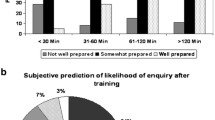Abstract
Although intimate partner violence (IPV) remains a major public health problem, physicians often fail to screen female patients. Reported IPV training approaches suffer from weak study designs and limited outcome assessments. We hypothesized that an educational experience for residents at a women’s safe shelter would have significantly greater impact on IPV competencies, screening, and care for victims than a workshop seminar alone. In a pre-post randomized controlled trial, we compared residents exposed to the workshop seminar alone (controls) to residents exposed to these methods plus an experience at a women’s safe shelter (cases). Competencies were assessed by written questionnaire and included knowledge, skills, attitudes, resource awareness, and screening behaviors. Of the 36 residents in the trial, 22 (61%) completed both pre- and postquestionnaires. Compared to controls, cases showed significantly greater pre-post improvement in the knowledge composite subscale. There were no significant differences between cases and controls in the subscales of skills, attitudes, or resource awareness. Cases increased their self-reported screening frequency but this did not differ significantly from the controls. Enhancing traditional IPV curriculum with a women’s safe shelter educational experience may result in small improvements in residents’ knowledge about IPV.
Similar content being viewed by others
References
Novello AC, Rosenberg M, Saltzman L, Shosky J. From the Surgeon General, US Public Health Service: a medical response to domestic violence. JAMA. 1992;267:31–2.
Gin NE, Rucker L, Frayne S, Cygan R, Hubbell FA. Prevalence of domestic violence among patients in three ambulatory care internal medicine clinics. J Gen Intern Med. 1991;6:317–22.
Kyriacou DN, Anglin D, Taliaferro E, et al. Risk factors for injury to women from domestic violence against women. N Engl J Med. 1999;341:1892–8.
McKenzie KC, Burns RB, McCarthy EP, Freund KM. Prevalence of domestic violence in an inpatient female population. J Gen Intern Med. 1998;13:277–9.
Bauer HM, Rodriguez MA, Perez-Stable EJ. Prevalence and determinants of intimate partner abuse among public hospital primary care patients. J Gen Intern Med. 2000;15:811–7.
Anonymous. From the Centers for Disease Control and Prevention. Prevalence of intimate partner violence and injuries—Washington, 1998. JAMA. 2000;284:559–60.
Bewley S, Friend JR, Mezey GC, eds. Violence Against Women. London, UK: RCOG Press; 1997.
Hayden SR. Domestic violence in the emergency department: how do women prefer to disclose and discuss the issues? J Emerg Med. 1997;15:447.
Rodriguez MA. Breaking the silence. Battered women’s perspectives on medical care. Arch Fam Med. 1996;5:153.
Caralis PV, Musialowski R. Women’s experiences with domestic violence and their attitudes and expectations regarding medical care of abuse victims. South Med J. 1997;90:1075.
Collins KS, Schoen C, Joseph S, et al. Health Concerns Across a Woman’s Lifespan: The Commonwealth Fund 1998 Survey of Women’s Health. New York: The Commonwealth Fund; 1999.
McGrath ME, Hogan JW, Peipert JF. A prevalence survey of abuse and screening for abuse in urgent care patients. Obstet Gynecol. 1998;91:511–4.
Rodriguez MA, Bauer HM, McLoughlin E, Grumbach K. Screening and intervention for intimate partner abuse: practices and attitudes of primary care physicians. JAMA. 1999;282:468–74.
Panagiota V, Caralis M, Musialowski R. Women’s experiences with domestic violence and their attitudes and expectations regarding medical care of abuse victims. South Med J. 1997;90:1076–80.
McCauley J, Yurk RA, Jenckes MW, Ford DE. Inside “Pandora’s box”: abused women’s experiences with clinicians and health services. J Gen Intern Med. 1998;13:549–55.
Reid SA, Glasser M. Primary care physicians’ recognition of and attitudes toward domestic violence. Acad Med. 1997;72:51–3.
Sugg NK, Inui T. Primary care physicians’ response to domestic violence. Opening Pandora’s box. JAMA. 1992;267:3157–60.
Sugg NK, Thompson RS, Thompson DC, Maiuro R, Rivara FP. Domestic violence and primary care. Attitudes, practices and beliefs. Arch Fam Med. 1999;8:301–6.
Cohen S, De Vos E, Newberger E. Barriers to physician identification and treatment of family violence: lessons from five communities. Acad Med. 1997;72:19S-25S.
Garimella R, Plichta SB, Houseman C, Garzon L. Physician beliefs about victims of spouse abuse and about the physician role. J Womens Health Gend Based Med. 2000;9:405–11.
Freund DM, Bak SM, Blackhall L. Identifying domestic violence in primary care practice. J Gen Intern Med. 1996;11:44–6.
Elliott L, Jones T, Friedmann PD. Barriers to screening for domestic violence. J Gen Intern Med. 2002;17:112–6.
Saunders DG, Kindry P. Predictors of physicians’ response to woman abuse: the role of gender, background and brief training. J Gen Intern Med. 1993;8:606–9.
Friedman L, Samet J, Roberts M, Hudlin M, Hans P. Inquiry about victimization experiences. Arch Intern Med. 1992;152:1186.
Elliott L, Nerney M, Jones T, Friedman PD. Barriers to screening for DV. J Gen Intern Med. 2002;17:112–6.
Zlotonick C, Powrie R. DV screening among medical residents: is the message getting through? J Interpers Violence. 2001;16:841–5.
Chang JC, Decker M, Moracco KE, Martin SL, Petersen R, Frasier P. What happens when health care providers ask about intimate partner violence? A description of consequences from the perspectives of women survivors. J Am Med Womens Assoc. 2003;58:76–81.
Hendricks MM. A survey of family-violence curricula in Virginia medical schools and residencies at university medical centers. Acad Med. 1997;72:54–6.
Kripke EN, Steele G, O’Brien MK, Novack DH. Domestic violence training program for residents. J Gen Intern Med. 1998;13:839–41.
Alpert EJ, Albright C, Webb S. Massachusetts Medical Society seminar series on domestic violence. Acad Med. 1999;74:821.
Magrane D, Ephgrave K, Jacobs MB, Rusch R. Weaving women’s health across clinical clerkships. Acad Med. 2000;75:1066–70.
Rovi S, Mouton CP. DV education in FP residencies. Fam Med. 1999;31:398–403.
Mandel JB, Marcotte DB. Teaching family practice residents to identify and treat battered women. J Fam Pract. 1983;17:708–16.
Thurston WE, McLeod L. Teaching 2nd year medical students about wife battering. Womens Health Issues. 1997;7:92–8.
Jonassen JA, Mazor K. Identification of factors that influence the likelihood of screening for DV by medical students and residents. Acad Med. 2001;76:529.
Fink MJ. Analyzing power relationships to teach about DV. Acad Med. 2001;76:528.
Cole TB. Is domestic violence screening helpful? JAMA. 2000;284:551–3.
Ramsay J, Richardson J, Carter YH, Davidson LL, Feder G. Should health professionals screen women for domestic violence? Systematic review. BMJ. 2002;2:561–4.
Davidson LL, Grisso JA, Garcia-Moreno C, Garcia J, King VJ, Marchant S. Training programs for healthcare professionals in domestic violence. J Womens Health Gend Based Med. 2001;10:953–69.
Jonassen JA, Pugnaire MP, Mazor K, et al. The effect of a domestic violence interclerkship on the knowledge, attitudes and skills of third-year medical students. Acad Med. 1999;74:821.
Baker NJ. Strategic footholds for medical education about domestic violence. Acad Med. 1995;70:982.
Spinola C. Developing and implementing an intervention: evaluation of an emergency department pilot on partner abuse. Eval Health Prof. 1998;21:91.
Haase C, Short PD, Chapman DM, Dersch SA. DV education in medical school: does it make a difference? Acad Emerg Med. 1999;6:855–7.
Sitterding HA, Adena T, Shields-Fobbs E. Spouse/partner violence education as a predictor of screening practices among physicians. J Contin Educ Health Prof. 2003;23:54–63.
Short LM, Cotton D, Hodgson CS. Evaluation of the module on domestic violence at the UCLA School of Medicine. Acad Med. 1997;71:S75-S92.
Reiss AJ, Roth JA, eds. Understanding and Preventing Violence. National Research Council. Washington, DC: National Academy Press; 1993, 1994.
Chalk R, King P, eds. Violence in Families: Assessing Prevention and Treatment Programs. Washington, DC: National Academy Press; 1998.
Nicolaidis C. The Voices of Survivors Documentary. Using patient narrative to educate physicians about domestic violence. J Gen Intern Med. 2002;17:117–24.
Doepel DG, Connel BA, Hoff LA. Understanding Psychological Trauma. Final Report Phase 1SBIR Grant, NIMH, 1 R43 MH51512-02. Boston, MA. 1994.
McCauley J, Jenckes MW, McNutt L. ASSERT: the effectiveness of a continuing medical education video on knowledge and attitudes about interpersonal violence. Acad Med. 2003;78:518–24.
Maiuro RD, Vitaliano PP, Sugg NK, et al. Development of a health care provider survey for domestic violence psychometric properties. Am J Prev Med. 2000;19:245–52.
Thompson RS, Rivara FP, Thompson DC, et al. Identification and management of domestic violence: a randomized trial. Am J Prev Med. 2000;19:253–63.
Author information
Authors and Affiliations
Corresponding author
Additional information
None of the authors had any potential conflicts of interest.
This work was completed while Dr. Brienza and Ms. Ladouceur were affiliated with Yale University Department of Internal Medicine.
Rights and permissions
About this article
Cite this article
Brienza, R.S., Whitman, L., Ladouceur, L. et al. Evaluation of a women’s safe shelter experience to teach internal medicine residents about intimate partner violence. J GEN INTERN MED 20, 536–540 (2005). https://doi.org/10.1111/j.1525-1497.2005.0100.x
Accepted:
Issue Date:
DOI: https://doi.org/10.1111/j.1525-1497.2005.0100.x




